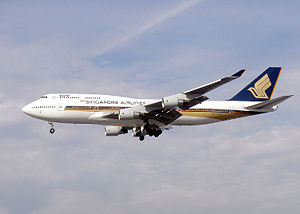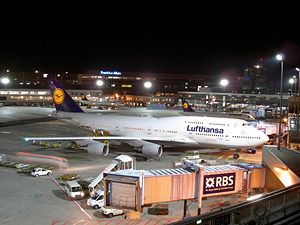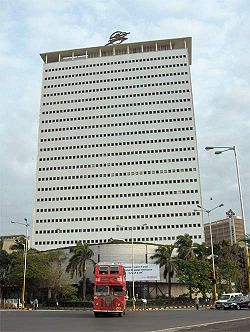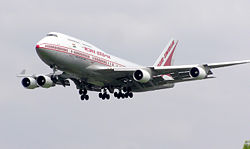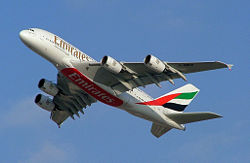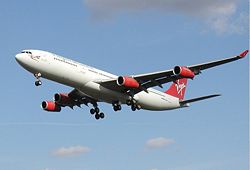Airline
An airline provides air transport services for passengers or freight. Airlines lease or own their aircraft with which to supply these services and may form partnerships or alliances with other airlines for mutual benefit.
Airlines vary in size and service, ranging from small companies with a few airplanes to large, international operations with hundreds of airplanes offering many services. Their services can be categorized as intercontinental, intracontinental, or domestic, and may be operated as scheduled services or charters. The demand for air travel services depends on a number of factors, including the need for cargo shipments, business passenger demand, leisure passenger demand, and economic factors.
The setting up of airline services is among the most important developments of human culture. It has made it easier to travel long distances, including overseas, in relative comfort and safety, at amazing speeds.
Patterns of operation
The pattern of ownership has gone from government-owned or supported to independent, for-profit public companies. This occurs as regulators permit greater freedom and non-government ownership, in steps that are usually decades apart. This pattern is not seen for all airlines in all regions.
The overall trend of demand has been consistently increasing. In the 1950s and 1960s, annual growth rates of 15 percent or more were common. Annual growth of five to six percent persisted through the 1980s and 1990s. Growth rates are not consistent in all regions, but countries with a deregulated airline industry have more competition and greater pricing freedom. This results in lower fares and sometimes dramatic spurts in traffic growth. The U.S., Australia, Japan, Brazil, Mexico, India and other markets exhibit this trend.
The industry is cyclical. Four or five years of poor performance precede five or six years of improved performance. But profitability in the good years is generally low, in the range of two to three percent net profit after interest and tax. In times of profit, airlines lease new generations of airplanes and upgrade services in response to higher demand. Since 1980, the industry has not earned back the cost of capital during the best of times. Conversely, in bad times losses can be dramatically worse.
Warren Buffett once said that despite all the money that has been invested in all airlines, the net profit is less than zero. He believes it is one of the hardest businesses to manage.
As in many mature industries, consolidation is a trend. Airline groupings may consist of limited bilateral partnerships, long-term, multi-faceted alliances between carriers, equity arrangements, mergers, or takeovers. Since governments often restrict ownership and merger between companies in different countries, most consolidation takes place within a country. In the U.S., over 200 airlines have merged, been taken over, or gone out of business since deregulation in 1978. Many international airline managers are lobbying their governments to permit greater consolidation to achieve higher economy and efficiency.
History
World's First Airline
DELAG, Deutsche Luftschiffahrts-Aktiengesellschaft (German: acronym for "German Airship Transport Corporation") was the world's first airline. It was founded on November 16, 1909, with government assistance, and operated airships manufactured by Zeppelin Corporation. Its headquarters were in Frankfurt. The four oldest non-dirigible airlines are the Netherlands' KLM, Colombia's Avianca, Australia's Qantas, and Mexico's Mexicana.
Early development of airlines in the U.S.
In the United States, Tony Jannus conducted the first scheduled commercial airline flight on January 1, 1914, for the St. Petersburg-Tampa Airboat Line. The 23-minute flight traveled between Saint Petersburg, Florida and Tampa, Florida, passing some 50 feet above Tampa Bay in Jannus' Benoist XIV biplane flying boat. Chalk's Airlines (now Chalk's International Airlines) began service between Miami and Bimini in the Bahamas in February 1919. Now based in Fort Lauderdale, Chalk's claims to be the oldest continuously operating airline in the United States.
Following World War I, the United States found itself swamped with aviators. Many decided to take their war-surplus aircraft on barnstorming campaigns, performing acrobatic maneuvers to woo crowds. In 1918, the United States Postal Service won the financial backing of Congress to begin experimenting with air mail service, initially using Curtiss Jenny aircraft that had been procured by the United States Army for reconnaissance missions on the Western Front.
Private operators were the first to fly the mail, but due to numerous accidents the U.S. Army was tasked with mail delivery. During the course of the Army's involvement they proved to be too unreliable and lost their air mail duties. By the mid-1920s, the Postal Service had developed its own air mail network, based on a transcontinental backbone between New York City and San Francisco. To supplant this service, they offered twelve contracts for spur routes to independent bidders: the carriers that won these routes would, through time and mergers, evolve into Delta Air Lines, Braniff Airways, American Airlines, United Airlines (originally a division of Boeing), Trans World Airlines, Northwest Airlines, and Eastern Air Lines, to name a few.
Passenger service during the early 1920s was sporadic: most airlines at the time were focused on carrying bags of mail. In 1925, however, the Ford Motor Company bought out the Stout Aircraft Company and began construction of the all-metal Ford Trimotor, which became the first successful American airliner. With a 12-passenger capacity, the Trimotor made passenger service potentially profitable. Air service was seen as a supplement to rail service in the American transportation network.
At the same time, Juan Trippe began a crusade to create an air network that would link America to the world, and he achieved this goal through his airline, Pan American World Airways, with a fleet of flying boats that linked Los Angeles to Shanghai and Boston to London. Pan Am was the only U.S. airline to fly internationally before the 1940s.
With the introduction of the Boeing 247 and Douglas DC-3 in the 1930s, the U.S. airline industry was generally profitable, even during the Great Depression. This trend continued until the beginning of World War II.
Early development of airlines in Europe

The first countries in Europe to embrace air transport were Finland, France, Germany and the Netherlands.
KLM, the oldest carrier still operating under its original name, was founded in 1919. The first flight transported two English passengers from London to Schiphol, Amsterdam, in 1920. Like other major European airlines of the time (see France and the UK below), KLM's early growth depended heavily on the need to service links with far-flung colonial possessions (Dutch Indies). It is only after the loss of the Dutch Empire that KLM found itself based at a small country with few potential passengers, depending heavily on transfer traffic, and was one of the first to introduce the hub-system to facilitate easy connections.
France began an air mail service to Morocco in 1919 that was bought out in 1927, renamed AĂ©ropostale, and injected with capital to become a major international carrier. In 1933, AĂ©ropostale went bankrupt, was nationalized and merged with several other airlines into what became Air France.
In Finland, the charter establishing Aero O/Y (now Finnair, one of the oldest still-operating airlines in the world) was signed in the city of Helsinki on September 12, 1923. Aero O/Y took delivery of its first aircraft on March 14, 1924. The first flight was between Helsinki and Tallinn, capital of Estonia, and it took place on March 20, 1924, one week later.
Germany's Lufthansa began in 1926. Lufthansa, unlike most other airlines at the time, became a major investor in airlines outside of Europe, providing capital to Varig of Brazil and Avianca. German airliners built by Junkers, Dornier, and Fokker were the most advanced in the world at the time. The peak of German air travel came in the mid-1930s, when Nazi propaganda ministers approved the start of commercial Zeppelin service: the big airships were a symbol of industrial might, but the fact that they used flammable hydrogen gas raised safety concerns that culminated with the Hindenburg disaster of 1937. The reason they used hydrogen instead of the not-flammable helium gas was a United States military embargo on helium.
The United Kingdom's flag carrier during this period was Imperial Airways, which became BOAC (British Overseas Airways Corporation) in 1939. Imperial Airways used huge Handley-Page biplanes for routes between London, the Middle East, and India: images of Imperial aircraft in the middle of the Rub'al Khali, being maintained by Bedouins, are among the most famous pictures from the heyday of the British Empire.
Development of airlines post-1945
As governments met to set the standards and scope for an emergent civil air industry toward the end of the war, it was no surprise that the U.S. took a position of maximum operating freedom. After all, U.S. airline companies were not devastated by the war, as European companies and the few Asian companies had been. This preference for "open skies" operating regimes continues, within limitations, to this day.
World War II, like World War I, brought new life to the airline industry. Many airlines in the Allied countries were flush from lease contracts to the military, and foresaw a future explosive demand for civil air transport, for both passengers and cargo. They were eager to invest in the newly emerging flagships of air travel such as the Boeing Stratocruiser, Lockheed Constellation, and Douglas DC-6. Most of these new aircraft were based on American bombers such as the Boeing B-29, which had spearheaded research into new technologies such as pressurization. Most offered increased efficiency from both added speed and greater payload.
In the 1950s, the De Havilland Comet, Boeing 707, Douglas DC-8, and Sud Aviation Caravelle became the first flagships of the "Jet Age" in the West, while the Soviet bloc countered with the Tupolev Tu-104 and Tupolev Tu-124 in the fleets of state-owned carriers such as the USSRâs Aeroflot]] and East Germanyâs Interflug. The Vickers Viscount and Lockheed L-188 Electra inaugurated turboprop transport.
The next big boost for the airlines would come in the 1970s, when the Boeing 747, McDonnell Douglas DC-10, and Lockheed L-1011 inaugurated widebody ("jumbo jet") service, which is still the standard in international travel. The Tupolev Tu-144 and its Western counterpart, Concorde, made supersonic travel a reality. In 1972, Airbus began producing Europe's most commercially successful line of airliners to date. The added efficiencies for these aircraft were often not in speed, but in passenger capacity, payload, and range.
In 1978, the U.S. airline industry deregulation lowered barriers for new airlines. In this period, new startups entered during downturns in the normal eight to ten year business cycle. At that time, they found aircraft, contracted hangar and maintenance services, trained new employees, and recruited laid-off staff from other airlines.
As the business cycle returned to normalcy, major airlines dominated their routes through aggressive pricing and additional capacity offerings, often swamping new startups. Dozens, even hundreds, have ceased operations.
In many ways, the biggest winner in the deregulated environment was the air passenger. Indeed, the U.S. witnessed an explosive growth in demand for air travel, as many millions who had never or rarely flown before became regular fliers, even joining frequent flyer loyalty programs and receiving free flights and other benefits from their flying. New services and higher frequencies meant that business fliers could fly to another city, do business, and return the same day, for almost any point in the country. Air travel's advantages put intercity bus lines under pressure, and most have withered away.
By the 1980s, almost half of the total flying in the world took place in the U.S., and today the domestic industry operates over ten thousand daily departures nationwide.
Toward the end of the century, a new style of low-cost airline emerged, offering a no-frills product at a lower price. In the United States, Southwest Airlines, JetBlue, AirTran Airways, Skybus Airlines and other low-cost carriers represent a serious challenge to today's "legacy" airlines, as do their low-cost counterparts in Europe, Canada, and Asia. Their commercial viability represents a serious competitive threat to the legacy carriers.
Thus during the last 50 years, the fortunes of the airline industry have ranged from reasonably profitable to devastatingly depressed. As the first major market to deregulate the industry (in 1978), U.S. airlines have experienced more turbulence than almost any other country or region. Today, almost every legacy carrier, except for American Airlines, has operated under Chapter 11 bankruptcy provisions or has gone out of business.
Regulatory considerations
Government regulation
Many countries have national airlines that the government owns and operates. Even fully-private airlines are subject to a great deal of government regulation for economic, political, and safety concerns. For instance, the government often intervenes to halt airline labor actions in order to protect the free flow of people, communications, and goods between different regions without compromising safety.
The deregulation of airlines has taken place to some degree in various countries, in addition to the United States. They include Australia, Brazil, Mexico, the United Kingdom, and Japan. In the past, these governments dictated airfares, route networks, and other operational requirements for each airline. Since deregulation, airlines have been largely free to negotiate their own operating arrangements with different airports, enter and exit routes easily, and to levy airfares and supply flights according to market demand.
The entry barriers for new airlines are lower in a deregulated market, and so the U.S. has seen hundreds of airlines start up (sometimes for only a brief operating period). This has produced far greater competition than before deregulation in most markets, and average fares tend to drop 20 percent or more. The added competition, together with pricing freedom, means that new entrants often take market share with highly reduced rates that, to a limited degree, full service airlines must match. This is a major constraint on profitability for established carriers, which tend to have a higher cost base.
As a result, profitability in a deregulated market is uneven for most airlines. These forces have caused some major airlines to go out of business, in addition to most of the poorly established new entrants.
International regulations
Groups such as the International Civil Aviation Organization establish worldwide standards for safety and other vital concerns. Most international air traffic is regulated by bilateral agreements between countries, which designate specific carriers to operate on specific routes. The model of such an agreement was the Bermuda Agreement between the U.S. and UK following World War II, which designated airports to be used for transatlantic flights and gave each government the authority to nominate carriers to operate routes.
Bilateral agreements are based on the "freedoms of the air," a group of generalized traffic rights ranging from the freedom to overfly a country to the freedom to provide domestic flights within a country (a very rarely granted right known as cabotage). Most agreements permit airlines to fly from their home country to designated airports in the other country: some also extend the freedom to provide continuing service to a third country, or to another destination in the other country while carrying passengers from overseas.
In the 1990s, "open skies" agreements became more common. These agreements take many of these regulatory powers from state governments and open up international routes to further competition. Open skies agreements have met some criticism, particularly within the European Union, whose airlines would be at a comparative disadvantage with the United States' because of cabotage restrictions.
Economic considerations
Historically, air travel has survived largely through state support, whether in the form of equity or subsidies. The airline industry as a whole has made a cumulative loss during its 120-year history, once the costs include subsidies for aircraft development and airport construction.[1]
One argument is that positive externalities, such as higher growth due to global mobility, outweigh the microeconomic losses and justify continuing government. A historically high level of government intervention in the airline industry can be seen as part of a wider political consensus on strategic forms of transport, such as highways and railways, both of which receive public funding in most parts of the world. Profitability is likely to improve in the future as privatization continues and more competitive low-cost carriers proliferate.
Although many countries continue to operate state-owned (or partially state-owned) airlines, many large airlines today are privately owned and are therefore governed by microeconomic principles in order to maximize shareholder profit.
Ticket revenue
Airlines assign prices to their services in an attempt to maximize profitability. The pricing of airline tickets has become increasingly complicated over the years and is now largely determined by computerized yield management systems.
Because of the complications in scheduling flights and maintaining profitability, airlines have many loopholes that can be used by the knowledgeable traveler. Many of these airfare secrets are becoming more and more known to the general public, so airlines are forced to make constant adjustments.
Most airlines use differentiated pricing, a form of price discrimination, in order to sell air services at varying prices simultaneously to different segments. Factors influencing the price include the days remaining until departure, the current booked load factor, the forecast of total demand by price point, competitive pricing in force, and variations by day of week of departure and by time of day. Carriers often accomplish this by dividing each cabin of the aircraft (first, business and economy) into a number of travel classes for pricing purposes.
A complicating factor is that of origin-destination control ("O&D control"). For example, someone purchasing a ticket from Melbourne to Sydney for $200 (AUD) is competing with someone else who wants to fly from Melbourne to Los Angeles through Sydney on the same flight, and who is willing to pay $1400 (AUD). Should the airline prefer the $1400 passenger, or the $200 passenger plus a possible Sydney-Los Angeles passenger willing to pay $1300? Airlines have to make hundreds of thousands of similar pricing decisions daily.
The advent of advanced computerized reservations systems in the late 1970s allowed airlines to easily perform cost-benefit analyses on different pricing structures, leading to almost perfect price discrimination in some cases (that is, filling each seat on an aircraft at the highest price that can be charged without driving the consumer elsewhere). The intense nature of airfare pricing has led to the term "fare war" to describe efforts by airlines to undercut other airlines on competitive routes. Through computers, new airfares can be published quickly and efficiently to the airlines' sales channels. For this purpose, the airlines use the Airline Tariff Publishing Company (ATPCO), which distributes latest fares for more than five hundred airlines to computer reservation systems across the world.
The extent of these pricing phenomena is strongest in "legacy" carriers. By contrast, low-fare carriers usually offer pre-announced and simplified price structures and often quote prices for each leg of a trip separately.
Computers also allow airlines to predict, with some accuracy, how many passengers will actually fly after making a reservation to fly. This allows airlines to overbook their flights enough to fill the aircraft while accounting for "no-shows," but not enough (in most cases) to force paying passengers off the aircraft for lack of seats. Flight occupancy is somewhat managed through stimulative pricing for low-demand flights coupled with overbooking on high-demand flights.
Operating costs
Full-service airlines have a high level of fixed and operating costs in order to establish and maintain air services: labor, fuel, airplanes, engines, spare parts, IT services and networks, airport equipment, airport handling services, sales distribution, catering, training, aviation insurance, and other costs. Thus all but a small percentage of the income from ticket sales is paid out to a wide variety of external providers or internal cost centers.
Moreover, the industry is structured such that airlines often act as tax collectors. Airline fuel is untaxed, however, due to a series of treaties between countries. Ticket prices include a number of fees, taxes, and surcharges they have little or no control over, and these are passed through to various providers. Airlines are also responsible for enforcing government regulations. If airlines carry passengers without proper documentation on international flights, they are responsible for returning the passengers to the originating country.
Analysis of the 1992-1996 period shows that every player in the air transport chain is far more profitable than the airlines, who collect and pass through fees and revenues to them from ticket sales. While airlines as a whole earned six percent return on capital employed (2-3.5 percent less than the cost of capital), airports earned ten percent, catering companies 10-13 percent, handling companies 11-14 percent, aircraft lessors 15 percent, aircraft manufacturers 16 percent, and global distribution companies more than 30 percent. (Source: Spinetta, 2000, quoted in Doganis, 2002)
By contrast, Southwest Airlines has been the most profitable airline company since 1970. Indeed, some sources have calculated Southwest to be the best performing stock over the period. The chief reasons for this success are product consistency and cost control.
The widespread entrance of a new breed of low-cost airlines beginning at the turn of the century has accelerated the demand that full service carriers control costs. Many of these low-cost companies emulate Southwest Airlines in various respects, and like Southwest, they are able to eke out a consistent profit throughout all phases of the business cycle.
As a result, a shakeout of airlines is occurring in the U.S. and elsewhere. United Airlines, US Airways (twice), Delta Air Lines, and Northwest Airlines have all declared Chapter 11 bankruptcy, and American Airlines has barely avoided doing so. Alitalia (Italy), Scandinavian Airlines System, SABENA (Belgium), Swissair, Japan Air System, Viasa (Venezuela), Air Canada, Ansett Australia, and others have flirted with or declared bankruptcy since 1995, as low-cost entrants enter their home markets as well.
Some argue that it would be far better for the industry as a whole if a wave of actual closures were to reduce the number of "undead" airlines competing with healthy airlines while being artificially protected from creditors via bankruptcy law. On the other hand, some have pointed out that the reduction in capacity would be short lived given that there would be large quantities of relatively new aircraft that bankruptcies would want to get rid of and would re-enter the market either as increased fleets for the survivors or the basis of cheap planes for new startups.
Where an airline has established an engineering base at an airport there may be considerable economic advantages in using that same airport as a preferred focus (or "hub") for its scheduled flights.
Assets and financing
Airline financing is quite complex, since airlines are highly-leveraged operations. Not only must they purchase (or lease) new airliners and engines regularly, they must make major long-term fleet decisions with the goal of meeting the demands of their markets while producing a fleet that is relatively economical to operate and maintain. Compare Southwest Airlines and their reliance on a single airplane type with the now defunct Eastern Air Lines which operated 17 different aircraft types, each with varying pilot, engine, maintenance, and support needs.
A second financial issue is that of hedging oil and fuel purchases, which are usually second only to labor in its relative cost to the company. However, with the current high fuel prices it has become the largest cost to an airline. While hedging instruments can be expensive, they can easily pay for themselves many times over in periods of increasing fuel costs, such as in the 2000-2005 period.
In view of the congestion apparent at many international airports, the ownership of slots at certain airports (the right to take-off or land an aircraft at a particular time of day or night) has become a significant tradable asset for many airlines. Clearly, take-off slots at popular times of the day can be critical in attracting the more profitable business traveler to a given airline's flight and in establishing a competitive advantage against a competing airline. If a particular city has two or more airports, market forces will tend to attract the less profitable routes, or those on which competition is weakest, to the less congested airport, where slots are likely to be more available and therefore cheaper. Other factors, such as surface transport facilities and onward connections, will also affect the relative appeal of different airports and some long distance flights may need to operate from the one with the longest runway.
Airline partnerships
Code sharing is the most common type of airline partnership; it involves one airline selling tickets for another airline's flights under its own airline code. An early example of this was Japan Airlines' code sharing partnership with Aeroflot in the 1960s on flights from Tokyo to Moscow: Aeroflot operated the flights using Aeroflot aircraft, but JAL sold tickets for the flights as if they were JAL flights. This practice allows airlines to expand their operations, at least on paper, into parts of the world where they cannot afford to establish bases or purchase aircraft.
Since airline reservation requests are often made by city-pairs, (such as "show me flights from Chicago to DĂŒsseldorf"), an airline that is able to code share with another airline for a variety of routes might be able to be listed as indeed offering a Chicago-DĂŒsseldorf flight. The passenger is advised however, that Airline 1 operates the flight from say Chicago to Amsterdam, and Airline 2 operates the continuing flight (on a different airplane, sometimes from another terminal) to DĂŒsseldorf. Thus the primary rationale for code sharing is to expand one's service offerings in city-pair terms so as to increase sales.
A more recent development is the airline alliance, which became prevalent in the 1990s. These alliances can act as virtual mergers to get around government restrictions. Groups of airlines such as the Star Alliance, Oneworld, and SkyTeam coordinate their passenger service programs (such as lounges and frequent flyer programs), offer special interline tickets, and often engage in extensive code sharing (sometimes systemwide). These are increasingly integrated business combinationsâsometimes including cross-equity arrangementsâin which products, service standards, schedules, and airport facilities are standardized and combined for higher efficiency.
Often the companies combine IT operations, buy fuel, or purchase airplanes as a bloc in order to achieve higher bargaining power. However, the alliances have been most successful at purchasing invisible supplies and services, such as fuel. Airlines usually prefer to purchase items visible to their passengers to differentiate themselves from local competitors. If an airline's main domestic competitor flies Boeing airliners, then the airline may prefer to use Airbus aircraft regardless of what the rest of the alliance chooses.
Customs and conventions
Each operator of a scheduled or charter flight uses a distinct airline call sign when communicating with airports or air traffic control centers. Most of these call-signs are derived from the airline's trade name, but for reasons of history, marketing, or the need to reduce ambiguity in spoken English (so that pilots do not mistakenly make navigational decisions based on instructions issued to a different aircraft), some airlines and air forces use call-signs less obviously connected with their trading name. For example, British Airways uses a Speedbird call-sign, named after the logo of its predecessor, British Overseas Airways Corporation, while America West used Cactus, reflecting that company's home in the state of Arizona and to differentiate itself from numerous other airlines using America and West in their call signs.
Airline personnel
The various types of airline personnel include:
- Flight crews, responsible for the operation of the aircraft. Flight crew members include:
- Pilots (captain and first officer; some older aircraft also require a flight engineer/second officer and/or navigator)
- Flight attendants (led by a purser on larger aircraft)
- In-flight security personnel on some airlines (also called âsky marshalsâ)
- Ground crews, responsible for operations at airports. Ground crew members include:
- Airframe and powerplant technicians
- Avionics technicians/engineers
- Flight dispatchers
- Baggage handlers
- Rampers
- Gate agents
- Ticket agents
- Passenger service agents (such as airline lounge employees)
- Reservations agents, usually (but not always) at facilities outside the airport
Most airlines follow a corporate structure where each broad area of operations (such as maintenance, flight operations, and passenger service) is supervised by a vice president. Larger airlines often appoint vice presidents to oversee each of the airline's hubs as well. Airlines also tend to employ considerable numbers of lawyers to deal with regulatory procedures and other administrative tasks.
See also
Notes
- â âWings of Desire,â Guardian Unlimited, February 23, 2006. Retrieved May 29, 2017.
ReferencesISBN links support NWE through referral fees
- Davies, R. E. G. A History of the World's Airlines. London: Oxford University Press, 1983. ISBN 978-0404193256
- Doganis, Rigas. The Airline Business in the 21st Century. New York: Routledge, 2000. ISBN 0415208823
- Doganis, Rigas. Flying Off Course: The Economics of International Airlines. London: Routledge, 2002. ISBN 0415213231
- Smith, Myron J. The Airline Encyclopedia, 1909-2000. Lanham, MD: Scarecrow Press, 2002. ISBN 0810837900
External links
All links retrieved June 16, 2023.
- International Civil Aviation Organization (ICAO)
- International Air Transport Association (IATA)
- Federal Aviation Administration (FAA)
- UK Civil Aviation Authority (CAA)
Credits
New World Encyclopedia writers and editors rewrote and completed the Wikipedia article in accordance with New World Encyclopedia standards. This article abides by terms of the Creative Commons CC-by-sa 3.0 License (CC-by-sa), which may be used and disseminated with proper attribution. Credit is due under the terms of this license that can reference both the New World Encyclopedia contributors and the selfless volunteer contributors of the Wikimedia Foundation. To cite this article click here for a list of acceptable citing formats.The history of earlier contributions by wikipedians is accessible to researchers here:
The history of this article since it was imported to New World Encyclopedia:
Note: Some restrictions may apply to use of individual images which are separately licensed.
